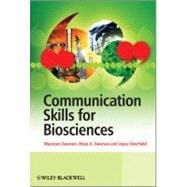
Note: Supplemental materials are not guaranteed with Rental or Used book purchases.
Purchase Benefits
What is included with this book?
Dr. Maureen Dawson, Department of Biological Sciences, Manchester Metropolitan University, UK
Brian A. Dawson, Secretary to the Faculty of Science and Engineering, University of Manchester, UK
Joyce Overfield, Senior Lecturer, School of Biology, Chemistry and Health Science, Manchester Metropolitan University, UK
| Preface | p. xi |
| Acknowledgements | p. xiii |
| Communication Skills in Science | p. 1 |
| About this chapter | p. 1 |
| Why are communication skills important for scientists? | p. 1 |
| Scientific writing: a little bit of history | p. 3 |
| Scientific language | p. 5 |
| Peer review | p. 6 |
| Basic rules for writing (scientific) English | p. 6 |
| Punctuation | p. 12 |
| More on plural words | p. 17 |
| Commonly confused words | p. 17 |
| Commonly misspelled words | p. 20 |
| UK and American English | p. 21 |
| Further reading | p. 22 |
| Using Scientific Literature | p. 23 |
| About this chapter | p. 23 |
| What is scientific literature? | p. 23 |
| Where to start | p. 28 |
| Peer review | p. 29 |
| Why use scientific literature for your assignments? | p. 30 |
| Reading the literature | p. 31 |
| Using material from the Internet | p. 42 |
| Plagiarism | p. 43 |
| Referencing conventions | p. 44 |
| The Harvard style of referencing | p. 45 |
| Quotations and how to cite and reference them | p. 47 |
| Using software to generate your references | p. 48 |
| Examples of citations and references | p. 48 |
| References | p. 59 |
| Further reading | p. 60 |
| Essay Writing | p. 61 |
| About this chapter | p. 61 |
| The purpose of assignments | p. 61 |
| Why write an essay? | p. 62 |
| Skills | p. 63 |
| Preparation | p. 63 |
| The paragraph | p. 69 |
| The sentence | p. 69 |
| General points of style | p. 71 |
| Plagiarism | p. 75 |
| Examination essays | p. 77 |
| Further reading | p. 80 |
| Writing Practical Reports | p. 83 |
| About this chapter | p. 83 |
| Introduction | p. 83 |
| Some general points | p. 84 |
| What to do before the practical session | p. 85 |
| During the practical session | p. 86 |
| How should it be written? | p. 87 |
| Other forms of report | p. 95 |
| Further reading | p. 96 |
| The Project Report | p. 97 |
| About this chapter | p. 97 |
| Introduction | p. 97 |
| How to begin | p. 98 |
| Writing the report | p. 101 |
| Dissertation-based projects | p. 108 |
| Ethical issues to consider when reporting your project work | p. 110 |
| And finally... | p. 111 |
| Further reading | p. 112 |
| Scientific Posters | p. 113 |
| About this chapter | p. 113 |
| Why use posters? | p. 113 |
| When to use a poster format | p. 114 |
| Designing a poster | p. 115 |
| Printing your poster | p. 120 |
| Examples of posters | p. 121 |
| Further reading | p. 124 |
| Oral Presentations | p. 125 |
| About this chapter | p. 125 |
| Introduction | p. 125 |
| Rules to follow and pitfalls to avoid | p. 126 |
| Presentations with a group of participants | p. 130 |
| Summary: a quick guide to oral presentations | p. 136 |
| Further reading | p. 137 |
| Preparing a Curriculum Vitae and Job Application | p. 139 |
| About this chapter | p. 139 |
| Introduction | p. 139 |
| The curriculum vitae | p. 141 |
| Covering letters | p. 144 |
| Application forms | p. 147 |
| How to write a good personal statement | p. 150 |
| Interviews | p. 151 |
| Personal development planning | p. 159 |
| Some terms | p. 159 |
| Further reading | p. 160 |
| Index | p. 161 |
| Table of Contents provided by Ingram. All Rights Reserved. |
The New copy of this book will include any supplemental materials advertised. Please check the title of the book to determine if it should include any access cards, study guides, lab manuals, CDs, etc.
The Used, Rental and eBook copies of this book are not guaranteed to include any supplemental materials. Typically, only the book itself is included. This is true even if the title states it includes any access cards, study guides, lab manuals, CDs, etc.